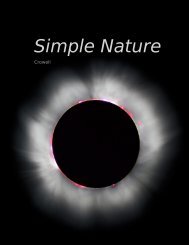The size of a radio antenna is closely related to ... - Light and Matter
The size of a radio antenna is closely related to ... - Light and Matter
The size of a radio antenna is closely related to ... - Light and Matter
You also want an ePaper? Increase the reach of your titles
YUMPU automatically turns print PDFs into web optimized ePapers that Google loves.
j / In the mirror image, the<br />
areas <strong>of</strong> positive excess traffic<br />
density are still positive, but<br />
the velocities <strong>of</strong> the cars have<br />
all been reversed, so areas <strong>of</strong><br />
positive excess velocity have<br />
been turned in<strong>to</strong> negative ones.<br />
k / A pulse encounters two<br />
boundaries.<br />
l / A sine wave has been reflected<br />
at two different boundaries, <strong>and</strong><br />
the two reflections interfere.<br />
<strong>The</strong> freeway traffic wave <strong>is</strong> in fact a good model <strong>of</strong> a sound wave,<br />
<strong>and</strong> a sound wave can likew<strong>is</strong>e be described either by the density<br />
(or pressure) <strong>of</strong> the air or by its speed. Likew<strong>is</strong>e many other types<br />
<strong>of</strong> waves can be described by either <strong>of</strong> two functions, one <strong>of</strong> which<br />
<strong>is</strong> <strong>of</strong>ten the derivative <strong>of</strong> the other with respect <strong>to</strong> position.<br />
Now let’s consider reflections. If we observe the freeway wave in<br />
a mirror, the high-density area will still appear high in density, but<br />
velocity in the opposite direction will now be described by a negative<br />
number. A person observing the mirror image will draw the<br />
same density graph, but the velocity graph will be flipped across the<br />
x ax<strong>is</strong>, <strong>and</strong> its original region <strong>of</strong> negative slope will now have positive<br />
slope. Although I don’t know any physical situation that would<br />
correspond <strong>to</strong> the reflection <strong>of</strong> a traffic wave, we can immediately apply<br />
the same reasoning <strong>to</strong> sound waves, which <strong>of</strong>ten do get reflected,<br />
<strong>and</strong> determine that a reflection can either be density-inverting <strong>and</strong><br />
velocity-uninverting or density-uninverting <strong>and</strong> velocity-inverting.<br />
Th<strong>is</strong> same type <strong>of</strong> situation will occur over <strong>and</strong> over as one encounters<br />
new types <strong>of</strong> waves, <strong>and</strong> <strong>to</strong> apply the analogy we need<br />
only determine which quantities, like velocity, become negated in a<br />
mirror image <strong>and</strong> which, like density, stay the same.<br />
A light wave, for instance, cons<strong>is</strong>ts <strong>of</strong> a traveling pattern <strong>of</strong> electric<br />
<strong>and</strong> magnetic fields. All you need <strong>to</strong> know in order <strong>to</strong> analyze the<br />
reflection <strong>of</strong> light waves <strong>is</strong> how electric <strong>and</strong> magnetic fields behave<br />
under reflection; you don’t need <strong>to</strong> know any <strong>of</strong> the detailed physics<br />
<strong>of</strong> electricity <strong>and</strong> magnet<strong>is</strong>m. An electric field can be detected, for<br />
example, by the way one’s hair st<strong>and</strong>s on end. <strong>The</strong> direction <strong>of</strong> the<br />
hair indicates the direction <strong>of</strong> the electric field. In a mirror image,<br />
the hair points the other way, so the electric field <strong>is</strong> apparently reversed<br />
in a mirror image. <strong>The</strong> behavior <strong>of</strong> magnetic fields, however,<br />
<strong>is</strong> a little tricky. <strong>The</strong> magnetic properties <strong>of</strong> a bar magnet, for instance,<br />
are caused by the aligned rotation <strong>of</strong> the outermost orbiting<br />
electrons <strong>of</strong> the a<strong>to</strong>ms. In a mirror image, the direction <strong>of</strong> rotation<br />
<strong>is</strong> reversed, say from clockw<strong>is</strong>e <strong>to</strong> counterclockw<strong>is</strong>e, <strong>and</strong> so the magnetic<br />
field <strong>is</strong> reversed twice: once simply because the whole picture<br />
<strong>is</strong> flipped <strong>and</strong> once because <strong>of</strong> the reversed rotation <strong>of</strong> the electrons.<br />
In other words, magnetic fields do not reverse themselves in a mirror<br />
image. We can thus predict that there will be two possible types <strong>of</strong><br />
reflection <strong>of</strong> light waves. In one, the electric field <strong>is</strong> inverted <strong>and</strong> the<br />
magnetic field uninverted (example 23, p. 699). In the other, the<br />
electric field <strong>is</strong> uninverted <strong>and</strong> the magnetic field inverted.<br />
6.2.3 Interference effects<br />
6.2.4 Interference effects<br />
6.2.5 Interference effects<br />
If you look at the front <strong>of</strong> a pair <strong>of</strong> high-quality binoculars, you<br />
will notice a green<strong>is</strong>h-blue coating on the lenses. Th<strong>is</strong> <strong>is</strong> advert<strong>is</strong>ed<br />
368 Chapter 6 Waves














